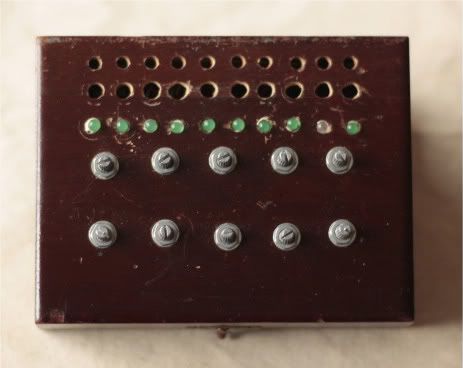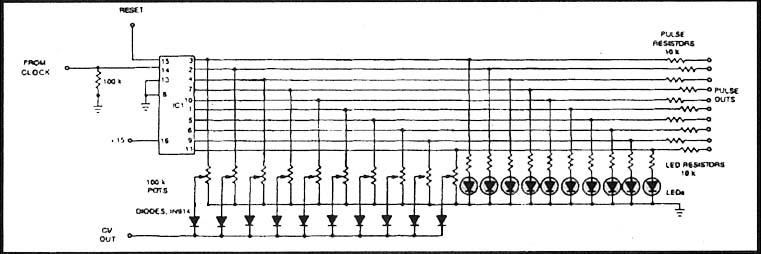The root drone heard in this sample was produced by running a signal from my 40106 Synthesizer into a piezo driver to vibrate the lid of a metal pot. I then built a small resonant tower on the lid with a large salad bowl and a mason jar filled with 2-4 ounces of water. I water-proofed a contact microphone and coiled it around the inside of the water glass to amplify the sound of the filtered signal and metal resonance. Slightly wobbling the resonant tower and shifting its components allowed for crude filtration. The harmonium melodies were improvised to the result, which was happily in tune with the acoustic instrument's own four constant reeds.
Tuesday, December 13, 2011
Friday, December 02, 2011
Matrix Mixer
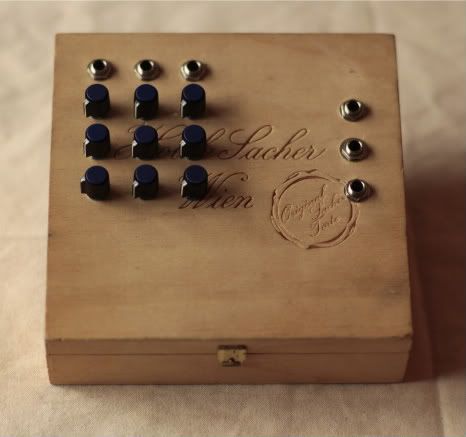 |
| A very rudimentary matrix mixer with three separate inputs, each of which can be mixed to three outputs. A simple means by which to run multiple instruments or devices through the same external effects, create feedback loops, or control the levels of microphones and piezo drivers. This is actually a very useful device, considering the fact that it requires no power source. I found this box at a local thrift store. Research suggests that it once contained a fine apricot-coated chocolate cake, the prized culinary production of the Hotel Sacher in Vienna, Austria. With the torte presumedly consumed long ago, its former dwelling has now become an avenue for aural fixations. |
Weird Sound Generator
Ray Wilson's "Weird Sound Generator" is capable of producing a wide spectrum of sounds, patterns, and textures. It is often described as one of the most versatile synthesizers for beginner builders and is the recipient of much comparison to cosmic phenomena. There are two separate voices, each comprised of three variable frequency oscillators. Two of these oscillators can be heard as sound output for each voice, or one can be used as a gate to filter the other. A third oscillator modulates the oscillator that provides gate control. Each voice has a switch to select between a triangular or square waveform output, as well as a switch to select between a gating function or dual frequency output. A low-pass filter with controllable levels of resonance and fine/coarse cutoff-frequency is another important feature.
WSG Sample I: Imitating LFO Pulse by Young Rites
WSG Sample II: Triangle Waves by Young Rites WSG Sample III: Gating and Modulation by Young Rites
Using the PCB layout design provided by MFOS, I transferred a toner image of the WSG circuit to a sheet of copper with an iron.Toner with a plastic base is not effected by etchant and creates a protective seal over the copper that it comes into contact with. I submerged the partially coated board in ferric chloride. Only the protected copper remained on the board after the acid bath, forming the conductive path between the circuit's soldered components.
Thursday, December 01, 2011
Candid Capacitance
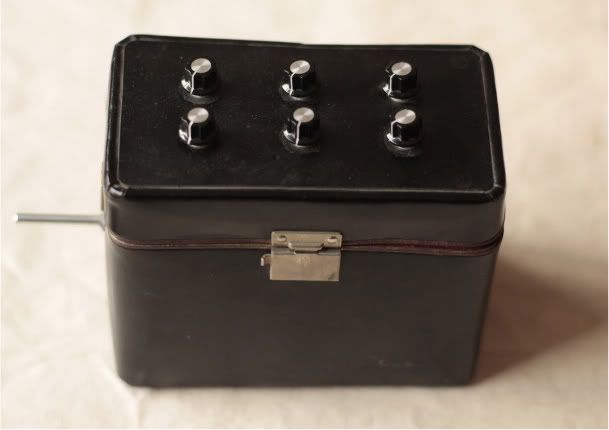 |
| Six distinct square wave pitches generated by the six Schmitt Triggers of a 40106 integrated circuit. Four of the feedback oscillators are mixed to the output with diodes, maintaing their respective pitches. The remaining two oscillators are mixed to the output with resistors. At higher frequencies, the two oscillators mixed with resistors have a slight modulating effect on the entire mixed output. As this synthesizer is one of my earliest builds, I improvised a very crude filtration device with a 2.2uf electrolytic capacitor and the linear taper potentiometer seen on one side. Despite its simplicity, this synth continues to surprise as it ages. The board is housed in an old camera case. I have come to regret removing the case's original strap, realizing that it could probably be used strikingly in a variety of performance contexts. Rusty, stark, and conjuring visions of juvenile bike rides and sea salt, it seems to encourage its own portability. |

40106 Synthesizer Sample I by Young Rites
The wet sounds of high frequency oscillation at the upward limits, accompanied by a "wupping" WSG.
40106 Synthesizer Sample II by Young Rites
Four constant square waves in unison. Imprecise chord progressions are enabled by changing the frequency of one oscillator at a time, slowly building a new chord around each change. This takes practice, but the difficulties of precisely harmonizing can also generate interesting discoveries. After transferring this recording from four track cassette to digital format, I duplicated the .wav file and slightly adjusted the duplicate's pitch to improve on flat transitions.
Works in Progress
Modeled after the Baby 10 Sequencer, this provisional device has only a control voltage output and an internal clock made from a 555 timer IC in astable mode. The 555 pulse rate is fed to the clock input function of a 4017 Decade Counter IC, to determine the rate at which the 4017 counts to ten. In place of the "patchable" pulse outputs shown in the schematic, I've hardwired the 4017 reset function to activate after the 10th pulse. This sequencer's future incarnation will be built into a housing case that is considerably more spacious and elegant than the crumbling microscope slide container it currently occupies. Ideally, it will include a switchable Clock Input, skip step switches, gate functions, and multiple CV outputs. A more philistine disposition might be content with the Incense Vessel plus Sequencer shown below. More on swinging censer instruments at a more leisurely point.
4093 Drone Synthesizer
This circuit, also in a testing stage, currently functions only as a NAND Gate synthesizer. It utilizes a Quad 2-input NAND Schmitt Trigger, the 4093 IC. As such, it is capable of sounding like the timed emissions of a dam system containing some kind of vile syrup. I will be basing my design and modifications off a schematic provided by 9_volts. I have successfully built two 4093 Drone Synths on PCBs designed by the Portland, OR based company, Synthrotek. These have been very inconsistent for my purposes, and I have made an unfortunate habit of destroying them. The schematic provided by 9_volts seems to enable a more intuitive instrument. Several months ago, I started to etch my own circuit boards in order to experiment with clones of Ray Wilson's "Weird Sound Generator" PCB, and to test PCB designs that I made with Eagle Cad software. The housing case that I prepared for this 4093 Drone Synth is the same that contains my WSG, shown in the final photo.

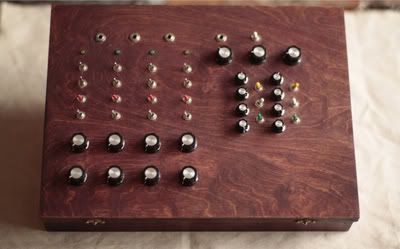 |
| 4093 Drone Synth (Left Side) and WSG (Right Side) Formerly an art supply case, I found this housing in a filthy condition among the abandoned belongings of a suddenly evicted neighbor. I cleaned it, sanded it, and stained it; then drilled into the surface and loaded it with medusoid circuitry. |
Wednesday, November 30, 2011
Demo Cassette
YOUNG RITES
Past Life Hangover/ Saturn Psalm I.
October 2011
C45 Edition of 100
Order: youngrites@gmail.com
Past Life Hangover
I. An Archer, a Dog
II. Malkuth
III.Homebody
IV. For Window/ Forever Dosed
V. Fire Take my Youth
Saturn Psalm I.
I. Saturn's Safeword
II. Third Life
III. Bayberry, Early On
IV. An Island Out and Within
V. The Brave Frost
Ten compositions recorded between 2009 and 2011.
Naive fingerstyle guitar, harmonium, and analog electronics.
Noise-laced folk that dwells in new ages of bleak and bliss.
Ten compositions recorded between 2009 and 2011.
Naive fingerstyle guitar, harmonium, and analog electronics.
Noise-laced folk that dwells in new ages of bleak and bliss.
Subscribe to:
Posts (Atom)




